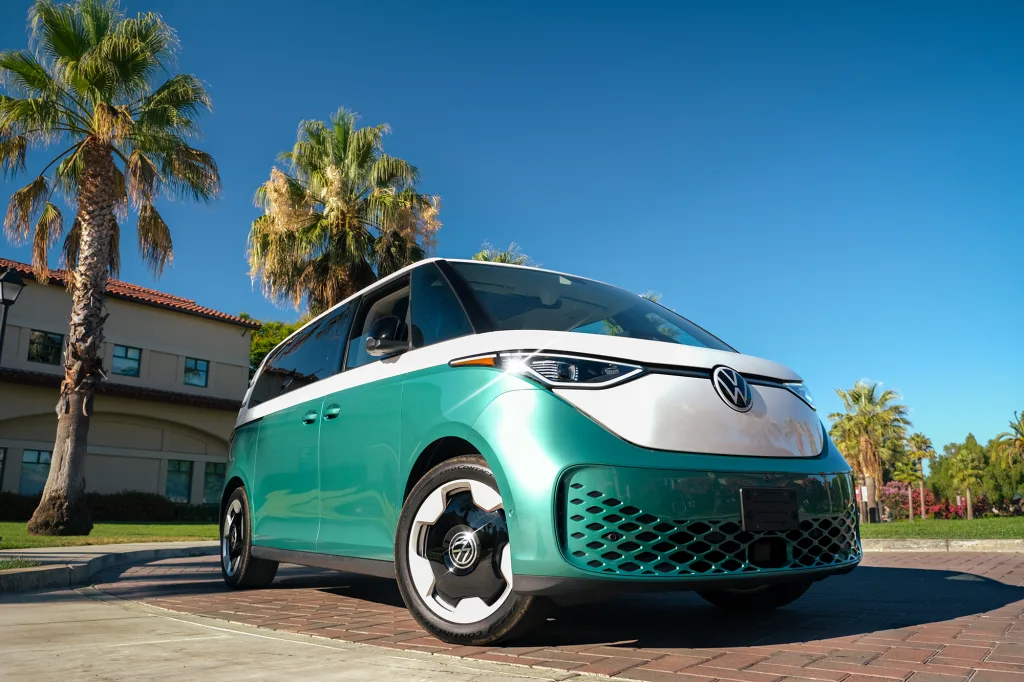I drove V.W.’s all-electric ID Buzz. It’s worth the wait
Volkswagen first unveiled the concept for the ID Buzz, the all-electric version of the classic hippie Microbus, in early 2017. Seven years later, it will finally be available this November in the U.S.—and I tried driving it. In late August, I recruited my brother to come along on a day trip, and we set off for Santa Cruz, a place where the 1960s version of the camper van still abounds. (Before we left, I took a spin around the block, and got a double-take from a passing school bus driver who flashed a peace sign.) On the winding road through the Santa Cruz mountains to get to the beach, we noticed the first advantage of the electric design: the giant battery, which fills up the space underneath the vehicle, helped weigh it down so it easily hugged tight curves on the road. [Photo: VW] Swiping my finger near the rear-view mirror activated my favorite feature on the fully-loaded version we tested: a roof made from electrochromic smart glass, which can instantly shift from opaque to transparent and back. While my brother drove on a back road through the redwoods, I gazed up at the view of the trees. When we pulled into the parking lot overlooking a state beach, the view from VW’s 360-degree “greenhouse” of windows was also spectacular. The van quickly drew a small crowd. One older couple told me stories about their trips in a 1968 Microbus, including some of the challenges of driving it. It reminded me of a VW van that a friend owned in high school, which sometimes struggled to make it up hills. It was loud, and smelled like gas. The modern version, unsurprisingly, is a much better ride. [Photo: VW] Since it’s electric, it’s quiet, and more responsive than a gas vehicle (on a highway on-ramp, you can nearly instantly accelerate to full speed). The seats are comfortable; with a push of a few buttons, they also heat up, cool down, or give you a massage. The vehicle has driver assistance tech, along with features found in other EVs, like navigation to the nearest charging station. (The navigation system was our only real complaint in the van: the UX design was terrible.) We only took a day trip, though the van seems well-designed for camping. The battery can help inflate an air mattress or run the AC on a hot night. Conversion kits from companies like Seattle-based Peace Vans can add more. Peace Vans’ PV Box, for example, adds a tiny kitchen with a sink, burner, and fridge to the back of the van. The van’s back seats can also be folded down to add a mattress. [Testing Volkswagen’s electric ID Buzz in California. Photo: Alex Peters] On our short trip, we couldn’t fully test the range of the vehicle. But it seemed to perform in line with the advertised range (234 miles per charge for the rear-wheel-drive version, and 231 miles for the all-wheel-drive version.) Despite going over the mountains twice, the battery still had plenty of charge remaining when we returned. The cost might be a barrier for some buyers—the van starts at $59,995, far more than the hippie original. But it’s possible that the vehicle could help boost Volkswagen’s slowing EV sales. [Photo: VW]

Volkswagen first unveiled the concept for the ID Buzz, the all-electric version of the classic hippie Microbus, in early 2017. Seven years later, it will finally be available this November in the U.S.—and I tried driving it.
In late August, I recruited my brother to come along on a day trip, and we set off for Santa Cruz, a place where the 1960s version of the camper van still abounds. (Before we left, I took a spin around the block, and got a double-take from a passing school bus driver who flashed a peace sign.) On the winding road through the Santa Cruz mountains to get to the beach, we noticed the first advantage of the electric design: the giant battery, which fills up the space underneath the vehicle, helped weigh it down so it easily hugged tight curves on the road.

Swiping my finger near the rear-view mirror activated my favorite feature on the fully-loaded version we tested: a roof made from electrochromic smart glass, which can instantly shift from opaque to transparent and back. While my brother drove on a back road through the redwoods, I gazed up at the view of the trees.
When we pulled into the parking lot overlooking a state beach, the view from VW’s 360-degree “greenhouse” of windows was also spectacular. The van quickly drew a small crowd. One older couple told me stories about their trips in a 1968 Microbus, including some of the challenges of driving it. It reminded me of a VW van that a friend owned in high school, which sometimes struggled to make it up hills. It was loud, and smelled like gas. The modern version, unsurprisingly, is a much better ride.

Since it’s electric, it’s quiet, and more responsive than a gas vehicle (on a highway on-ramp, you can nearly instantly accelerate to full speed). The seats are comfortable; with a push of a few buttons, they also heat up, cool down, or give you a massage. The vehicle has driver assistance tech, along with features found in other EVs, like navigation to the nearest charging station. (The navigation system was our only real complaint in the van: the UX design was terrible.)
We only took a day trip, though the van seems well-designed for camping. The battery can help inflate an air mattress or run the AC on a hot night. Conversion kits from companies like Seattle-based Peace Vans can add more. Peace Vans’ PV Box, for example, adds a tiny kitchen with a sink, burner, and fridge to the back of the van. The van’s back seats can also be folded down to add a mattress.

On our short trip, we couldn’t fully test the range of the vehicle. But it seemed to perform in line with the advertised range (234 miles per charge for the rear-wheel-drive version, and 231 miles for the all-wheel-drive version.) Despite going over the mountains twice, the battery still had plenty of charge remaining when we returned.
The cost might be a barrier for some buyers—the van starts at $59,995, far more than the hippie original. But it’s possible that the vehicle could help boost Volkswagen’s slowing EV sales.























